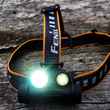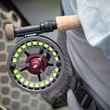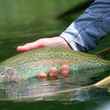The areas below waterfalls, both big and small, can be great places to seek out big trout. This should come as no surprise. Typically referred to as plunge pools, the water that sweeps over falls and into these pools continuously delivers all manner of food to fish waiting below. In areas where the plunging water is pinched or otherwise funneled by the structure of the stream, falls not only deliver food that has swept down from above but also produce a concentrated, high density stream of that food. The turbulent nature of water on the surface of a plunge pool serves to obscure and conceal everything below, providing excellent cover from predators. And despite the turbulent, often violent currents at the surface of these pools, the deep, sometime boulder-filled recesses below offer respite from strong currents.
Don't Pass Them By
Bigger trout push smaller trout out of prime lies. That's the way it goes. So, the fact that these pools offer up a bounty all of a trout's most important needs: cover, food and protection from currents, makes them prime lies. This, in turn, means that they will commonly hold some of the best trout in the stream. Still, I've seen many a fisherman pass them by or ply them only momentarily, put off by the chaotic nature of the water's flow or unwilling to strap on 14 pieces of split shot in order to get their fly down to the fish hiding below.





























